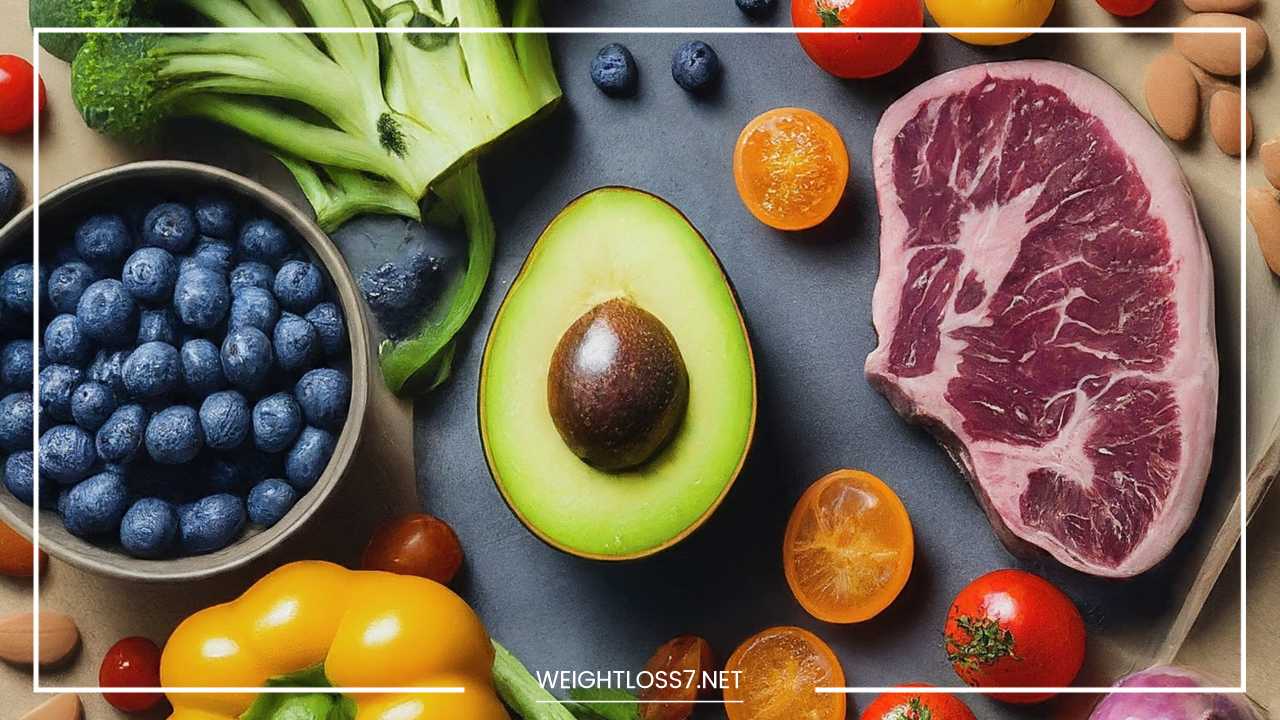Primal Blueprint Diet: Benefits, Drawbacks, and Getting Started

Primal Blueprint Diet
Embracing Our Ancestors: A Comprehensive Look at the Primal Blueprint Diet
In the ever-evolving landscape of dietary trends, the Primal Blueprint diet stands out as a philosophy rooted in the deep wellspring of our evolutionary past.
Developed by Mark Sisson, a former elite athlete and health advocate, this approach to eating draws inspiration from the presumed dietary patterns of our hunter-gatherer ancestors.
This comprehensive blog post delves into the core principles of the Primal Blueprint, explores the scientific underpinnings of its potential benefits and drawbacks, and offers practical guidance on incorporating it into your lifestyle for long-term success.
The Primal Blueprint: A Return to Our Evolutionary Blueprint
The Primal Blueprint revolves around the central idea that our bodies are optimally designed to thrive on the types of foods our hunter-gatherer ancestors consumed – think lean meats, fish, vegetables, fruits, nuts, and seeds.
Proponents of this diet believe that the modern world’s abundance of processed foods, refined grains, and added sugars disrupts our natural metabolic state, contributing to a rise in chronic health issues like obesity, heart disease, and type 2 diabetes.
Essentially, the Primal Blueprint posits that our genetic makeup hasn’t had enough time to adapt to the dramatic dietary shifts of the past few millennia.
We’re still wired for the nutrient profile of a hunter-gatherer diet, and aligning our modern food choices with this evolutionary blueprint can unlock a multitude of health benefits.
Core Principles of the Primal Blueprint: A Deep Dive
-
Prioritizing Whole, Unprocessed Foods: The cornerstone of the Primal Blueprint lies in emphasizing unprocessed, whole foods in their natural state. This means filling your plate with plenty of:
- Meat, Poultry, and Fish: Grass-fed and pasture-raised meats, wild-caught fish, and poultry are excellent sources of high-quality protein, essential fats, and micronutrients like iron, zinc, and B vitamins.
- Vegetables: A vibrant rainbow of vegetables provides a wealth of vitamins, minerals, fiber, and antioxidants. Focus on including leafy greens, cruciferous vegetables (broccoli, cauliflower), and root vegetables (carrots, sweet potatoes).
- Fruits: While some fruits are limited due to their higher sugar content, berries and low-glycemic fruits like apples can be enjoyed in moderation for their vitamin and fiber content.
- Nuts, Seeds, and Healthy Fats: Nuts, seeds, avocados, and olive oil are excellent sources of healthy fats, essential for hormone production, satiety, and nutrient absorption.
-
Limiting Grains and Legumes: Grains (including wheat, barley, and corn) and legumes (beans, lentils) are significantly restricted or avoided altogether in the Primal Blueprint. This stems from the belief that these foods can contribute to blood sugar spikes, inflammation, and digestive issues in some individuals.
-
Embracing Healthy Fats: The Primal Blueprint encourages incorporating healthy fats like those found in avocados, nuts, seeds, and olive oil. These fats provide satiety, support hormone production, and contribute to nutrient absorption. Importantly, the diet differentiates between healthy fats and unhealthy fats found in processed foods and refined vegetable oils.
-
Minimizing Processed Foods and Added Sugars: Processed foods, sugary drinks, and artificial sweeteners are deemed detrimental on the Primal Blueprint. These foods are thought to contribute to weight gain, metabolic dysfunction, chronic disease, and disrupt hormonal balance.
-
Prioritizing Sleep and Exercise for Overall Well-being: The Primal Blueprint goes beyond just food. It emphasizes the importance of quality sleep for hormonal balance, cellular repair, and cognitive function. Aim for 7-8 hours of quality sleep each night. Additionally, regular exercise that mimics our ancestral movement patterns – think sprinting, climbing, carrying heavy objects, and functional movements – is encouraged.
The Science Behind the Primal Blueprint: Exploring Potential Benefits
The Primal Blueprint draws on evolutionary theory and emerging nutritional science to support its proposed benefits. Let’s delve deeper into the science behind some of the potential benefits:
-
Weight Management: By eliminating processed foods, refined sugars, and limiting grains, the Primal Blueprint can lead to a reduction in overall calorie intake. This calorie deficit can promote weight loss and improve body composition.
-
Improved Blood Sugar Control: The focus on whole foods and limited grains helps regulate blood sugar levels. This can be particularly beneficial for individuals with prediabetes, type 2 diabetes, or those seeking to improve insulin sensitivity.
-
Reduced Inflammation: Chronic inflammation is linked to various health problems, including heart disease, autoimmune disorders, and even cancer. The emphasis on healthy fats and elimination of processed foods in the Primal Blueprint may contribute to a decrease in chronic inflammation.
-
Increased Energy Levels: The Primal Blueprint can promote sustained energy levels by providing your body with a steady stream of nutrients from whole foods and healthy fats. This can lead to improved focus, better physical performance, and a sharper mind, allowing you to tackle your day with increased vitality and motivation.
-
Improved Gut Health: The Primal Blueprint, with its emphasis on whole foods and fiber-rich vegetables, can contribute to a healthier gut microbiome. This diverse community of gut bacteria plays a crucial role in digestion, nutrient absorption, immune function, and even mood regulation.
-
Reduced Risk of Chronic Diseases: While more research is needed, the potential benefits of the Primal Blueprint on weight management, blood sugar control, and inflammation may translate to a reduced risk of chronic diseases like heart disease, type 2 diabetes, and certain cancers.
Considerations and Potential Drawbacks: A Balanced Perspective
While the Primal Blueprint offers a compelling approach to dietary choices, it’s essential to consider some potential drawbacks and ensure a well-rounded perspective:
-
Limited Food Choices: Restricting grains, legumes, and some fruits can limit dietary variety. This may pose challenges for some individuals and make social situations more difficult. Finding creative ways to incorporate the core principles into your meals is key.
-
Potential Nutrient Deficiencies: Limiting certain food groups can increase the risk of nutrient deficiencies, particularly if not carefully planned. Deficiencies in fiber, certain B vitamins, and minerals like calcium can occur. Consulting a registered dietitian can help ensure you’re getting all the essential nutrients by incorporating appropriate substitutions or supplements.
-
Sustainability: The strictness of the Primal Blueprint might be challenging to maintain long-term, especially for individuals with busy lifestyles or social commitments. Finding a flexible approach that suits your individual needs and preferences is crucial for long-term success. Consider the 80/20 rule: strive for 80% adherence to the core principles and allow for occasional indulgences within reason.
-
Limited Scientific Research: While the Primal Blueprint draws on evolutionary theory and emerging nutritional science, there’s limited high-quality research directly comparing it to other diets. More long-term studies are needed to definitively establish its effectiveness for various health outcomes.
Getting Started with the Primal Blueprint: A Practical Guide
If you’re interested in exploring the Primal Blueprint, here are some practical steps to get you started:
- Focus on Whole Foods: Gradually transition your meals to incorporate more grass-fed meats, wild-caught fish, organic vegetables, and healthy fats like avocados, nuts, and olive oil.
- Incorporate Limited Fruits: Berries and low-glycemic fruits like apples can be enjoyed in moderation. Experiment with incorporating them into breakfast smoothies or as a post-workout snack.
- Embrace Healthy Fats: Cook with healthy oils like olive oil or avocado oil. Include nuts, seeds, and avocados in your meals for added fat and satiety.
- Limit Processed Foods: Gradually reduce your intake of processed foods, sugary drinks, and refined grains. Plan your meals and snacks to avoid temptation. Stock your pantry with healthy staples like whole food grains (if you choose to include them), canned beans and lentils (if tolerated), and frozen vegetables for convenience.
- Prioritize Sleep and Exercise: Aim for 7-8 hours of quality sleep each night. Develop a regular exercise routine that incorporates a variety of activities, including strength training, cardio, and functional movements. Consider activities like sprinting intervals, bodyweight exercises, or joining a CrossFit gym.
Remember:
The Primal Blueprint might not be a perfect fit for everyone. It’s crucial to listen to your body and consult a healthcare professional or registered dietitian before making significant dietary changes.
They can help you adapt the Primal Blueprint principles to your unique needs and health goals. Additionally, be mindful of potential food sensitivities or allergies that may require further modifications to the diet.
Embrace the Primal Lifestyle: A Journey Towards a Healthier You
The Primal Blueprint offers a unique perspective on dietary choices, encouraging a return to whole, unprocessed foods and a lifestyle that aligns more closely with our evolutionary heritage.
By incorporating its core principles, tailoring them to your individual needs, and prioritizing overall well-being, you can embark on a journey towards a healthier, more vibrant you.
Remember, consistency is key. Celebrate your progress, and don’t be discouraged by occasional setbacks.
The Primal Blueprint Lifestyle: Beyond the Plate
The core principles of the Primal Blueprint extend beyond just dietary choices. It emphasizes a holistic approach to health and well-being, incorporating aspects of lifestyle that mimic those of our hunter-gatherer ancestors.
Here are some additional considerations to embrace a more comprehensive Primal lifestyle:
-
Stress Management: Chronic stress can wreak havoc on our hormones, blood sugar levels, and overall health. The Primal Blueprint encourages incorporating stress-management techniques like meditation, yoga, spending time in nature, and fostering strong social connections to combat the negative effects of stress.
-
Sunlight Exposure: Our ancestors spent a significant amount of time outdoors, receiving ample sunlight exposure. Sunlight exposure is crucial for vitamin D production, which plays a vital role in bone health, immune function, and mood regulation. Aim for daily exposure to natural sunlight, but be mindful of sunburns and overexposure.
-
Movement Throughout the Day: Hunter-gatherers were constantly on the move, engaging in activities like foraging, hunting, and carrying heavy loads. The Primal Blueprint encourages incorporating more movement throughout the day beyond structured workouts. Take the stairs instead of the elevator, park further away from your destination, or do some bodyweight exercises during commercial breaks.
-
Connecting with Nature: Spending time in nature has a multitude of benefits for both physical and mental health. Immersing yourself in nature can reduce stress, improve mood, and boost cognitive function. Go for hikes, spend time gardening, or simply relax in a nearby park.
-
Sleep Optimization: As mentioned earlier, quality sleep is crucial for optimal health. The Primal Blueprint emphasizes creating a sleep-conducive environment, establishing a regular sleep schedule, and avoiding screens before bed to promote deeper, more restorative sleep.
The Primal Blueprint Community: Support on Your Journey
The Primal Blueprint community is a valuable resource for anyone interested in exploring this dietary and lifestyle approach. Here are some ways to connect with the community:
- The Primal Blueprint Website: The Primal Blueprint website offers a wealth of information, articles, recipes, and a forum where you can connect with others following the Primal Blueprint lifestyle.
- Primal Blueprint Books: Mark Sisson, the founder of the Primal Blueprint, has authored several books outlining the core principles and practical steps for implementing this approach.
- Social Media: The Primal Blueprint has a presence on various social media platforms like Facebook, Instagram, and Twitter. These platforms offer a way to connect with others, ask questions, and get inspired by success stories.
A Final Note: Individualized Adaptation is Key
Remember, the Primal Blueprint serves as a framework, not a rigid set of rules. The key is to adapt the core principles to your unique needs, preferences, and lifestyle.
Be mindful of any pre-existing health conditions and consult with a healthcare professional or registered dietitian before making significant dietary changes.
With dedication, flexibility, and a commitment to overall well-being, the Primal Blueprint can empower you to take charge of your health and live a more vibrant life.

















